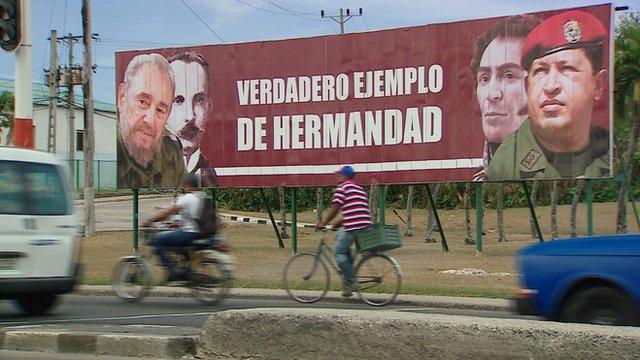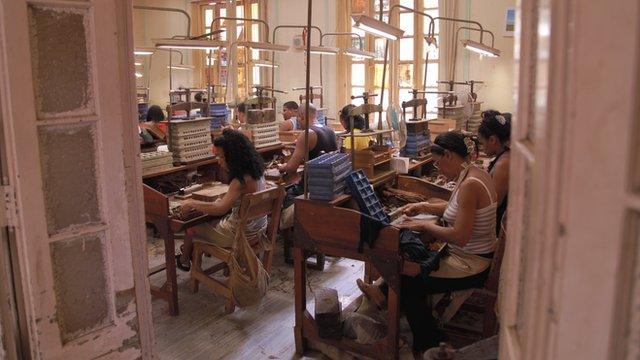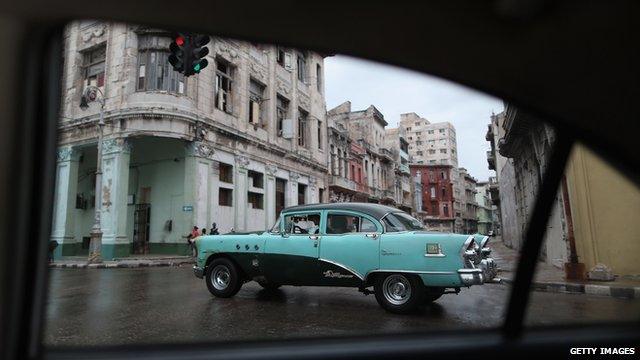Scenes from a warming Cuba-US relationship
- Published
- comments
Jon Sopel reports from Havana on Cuban reaction to growing relations between Cuba and the US
It's not long after you leave Havana Airport that you realise why an improvement in relations between Cuba and the US is so important.
There, at the end of the road going away from the terminal, is a giant poster, the colours somewhat faded, showing a picture of Fidel Castro on one side and the now dead Venezuelan leader, Hugo Chavez, on the other. They are brothers, it declares.
And they were. Cuba's economy was kept afloat on Venezuelan oil. Before Venezuela it was Soviet aid that helped keep Cuba going.

A billboard reads: "True Example of Brotherhood"
But now that the oil price has collapsed and the Venezuelan economy is spinning out of control, a rapprochement with Cuba's giant of a northern neighbour could not come at a better time.
Yes, it was a major jump when the two presidents set out a new course for their countries last December. But there is a long way to go.
The 1950s-built US embassy on the waterfront still stands empty - although an eagle eyed journalist did spot the flagpole being repainted the other day, a harbinger of things to come, perhaps.

The US Interest Office lies in wait, soon to possibly be converted into an embassy
Castro and Obama are scheduled to meet at the Americas conference at the weekend in Panama - the first official meeting between a sitting US president and his Cuban counterpart since the Batista government was overthrown.
And expectation is growing that Cuba will soon be taken off the "state sponsor of terrorism" list that the US State Department compiles.
Travel has already been made a bit easier for Americans wanting to visit - though the hoops that you have to go through will likely deter the casual American traveller. And the big prize, of course, is trade. When will the embargo on Cuban goods be lifted?
Once those obstacles to normalisation (such an ugly word) are removed then the potential is enormous.

We went to one of the most amazing factories I have ever visited.
In pre-revolutionary times it was a splendid, colonial palace on Havana's most prestigious tree lined road - all white stucco and marble columns.
But Castro gave it to the country's cigar producers. And in every room sit rows of men and women, lovingly hand rolling every cigar that are exported around the world.


Habanos Cigars is a private company - but in the room where the final bits of quality control are carried out there is a huge portrait of Che Guevara looking down on the workers. A global prestige product with a whiff of revolution.
The US market is thought to be worth around $3bn. But for the last half century, Cuba has been shut out from it.
Just imagine the potential for growth in sales once America opens up. Cuban rum manufacturers are eyeing up similar opportunities.
And in the other direction, you can be sure that American corporations will be looking at the opportunities to invest in Cuba - whether it be hotel groups or fast food chains.


There will be no shortage of American car dealers wanting to buy up all the wonderful 1950s American cars that still fill the streets of Havana.
When the trade ban came, Cubans had to keep these cars on the road because they couldn't buy new ones. Now these gas guzzling, chrome lined, finned and winged monsters are total collectors items.
You just look at Cuba's crumbling infrastructure and you see the need for investment.
But here's the thing, and the challenge for the country's ageing political elite.
How to exploit economic opportunities while keeping Cuba the distinctive, raucous, friendly and exuberant place it is today.